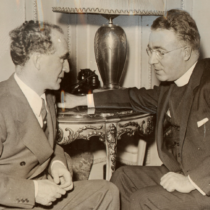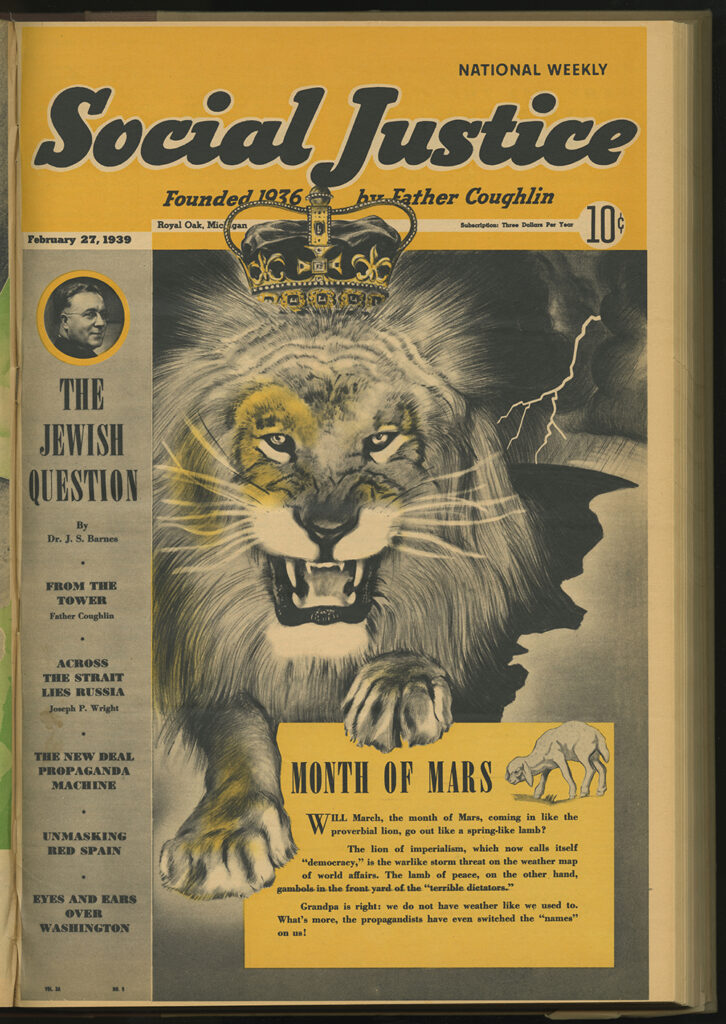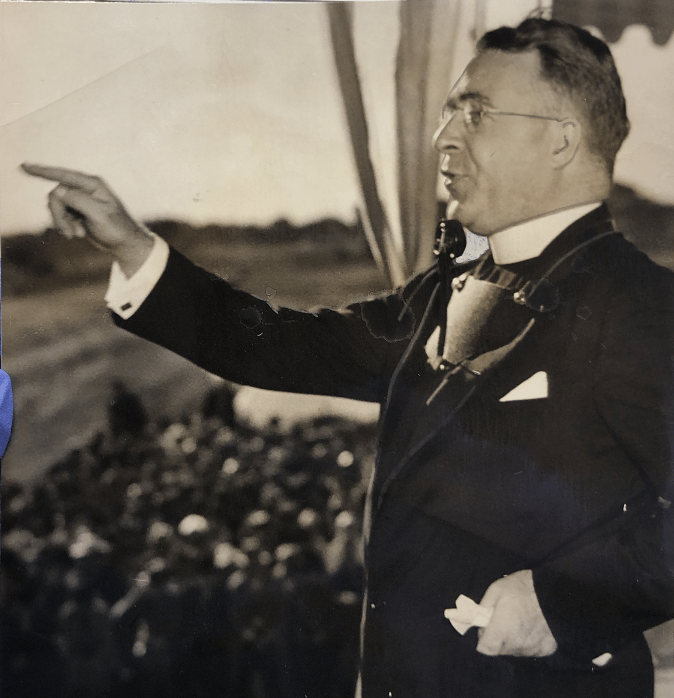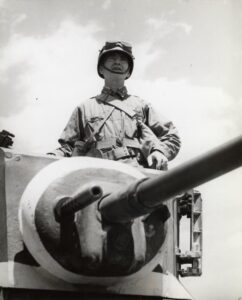Magazine

The Politician and the Traitor
Father Charles Coughlin was a Catholic priest and popular radio host who counted politicians, and even President Franklin D. Roosevelt, among his many friends. Closest in his circle of influence was Michigan Governor Frank Murphy. But by the start of World War II, Murphy would cut ties with the priest, who would find himself in the throes of a treason investigation. Archived papers at the Bentley help tell the story of what happened – and why.
By Lara Zielin
The quiet March night in Royal Oak, Michigan, was shattered at 3:00 a.m. with a terrible explosion. A bomb had been lowered into the basement of a private home on Fairlawn Street, and the blast ripped through a steam pipe and shattered windows. Canned goods were ruptured and splattered.
Within minutes, the police arrived. Guards were placed around the house. Then, none other than Detroit’s Mayor, Frank Murphy, arrived on the scene.
Murphy was there to comfort and help the blast’s intended victim: Father Charles E. Coughlin, a Catholic priest and a personal friend of Murphy.
It was 1933, at the height of the Great Depression. Coughlin had a popular radio show that reached millions of listeners, giving them hope amidst terrible economic circumstances.
Together, Coughlin and Murphy had worked hard on behalf of those hit hardest by the Depression by setting up food distribution centers and lodging houses. As a team, they stumped tirelessly for Roosevelt, helping him win the White House in 1932. Murphy even helped Coughlin write some of his speeches during this time.
It makes sense, then, that Coughlin would call Murphy for aid after his home had been bombed.
But the bomb itself was a sign that Coughlin’s role was changing, going beyond that of a typical Catholic priest to one that was far more political—not to mention divisive.
Coughlin told The New York Times he assumed the bomb in his house was “an act of intimidation” in response to his highly critical broadcasts against Detroit bankers and a Depression-era banking plan.
Murphy had already tried to get Coughlin to tone down his anti-banking rhetoric, but had failed. Now, here was Murphy again, this time in the dead of night, trying once again to help Coughlin out of a scrape.
For the next decade, this pattern would continue. As Coughlin grew more political, Murphy would do his best to rein in his friend and keep him from alienating allies and the listeners of his successful radio program.
But to no avail.
Coughlin’s rhetoric would become increasingly antisemitic and isolationist as the U.S. tipped toward full involvement in World War II. Eventually, Coughlin would come dangerously close to being indicted on sedition charges.
As papers at the Bentley reveal, Frank Murphy tried to pull Coughlin from the edge time and again. Eventually, Murphy would have to give up the fight and admit that his one-time friend had turned U.S. traitor. And maybe even worse.

Coughlin’s fascist and antisemitic “Social Justice” newsletter would ultimately be labeled enemy propaganda, in violation of the Espionage Act. [HS20092]
The Influencer and the Oval Office
In the early- to mid-1930s, nearly 30 million people tuned into Father Coughlin’s weekly radio broadcasts on Sunday, roughly a quarter of the U.S. population at the time. More than 30,000 people flocked to his church in Royal Oak on Sundays, called the Shrine of the Little Flower. One survey at the time stated Coughlin was the most important person in the United States behind the president.
There’s no question Coughlin used his radio program to persuade the American people to vote for Franklin Delano Roosevelt in the 1932 election. Coughlin’s brand of social justice and reform fit well with New Deal policies, and he painted Roosevelt as an American savior.
Coughlin and Roosevelt were reportedly close after Roosevelt had secured the White House. Coughlin told one interviewer he was with the president every couple weeks. And of course Coughlin made sure to put in a good word for his friend Frank Murphy, eventually taking credit for Murphy’s appointment as governor general to the Philippines, then a U.S. territory, in 1933.
But however close Coughlin thought he was to Roosevelt, it apparently wasn’t close enough. Coughlin had specific ideas and policies he wanted Roosevelt to implement, including substituting silver for gold for the money standard. When the president ignored him, Coughlin seethed.
In an archived letter in the Bentley’s Frank Murphy collection from January 1934, Coughlin complained about how his affection for the president went unreciprocated: “I have had no contact either directly or indirectly with the president since you left [for the Philippines]. Sometimes I am of the opinion that while I certainly rebuilt the confidence of the people in him, a confidence which had been greatly impaired, I sometimes wonder whether or not he favors my being with him.”
Gradually, Coughlin’s speeches became increasingly critical of President Roosevelt, questioning his judgment and policies. In 1934, William Walker, a friend of Murphy, wrote to Murphy in the Philippines to note that Coughlin was “getting in Dutch,” meaning he was getting in trouble or disfavor with his critical rhetoric and was “on the toboggan,” or on the decline.

Coughlin tells a crowd in 1936 to vote agains Roosevelt and the New Deal. [Charles E. Coughlin Photograph Collection]
At the same time, others were writing to Murphy asking if he might use his friendship with the still-popular radio star to their benefit. John D. Dingell Sr. (father of John D. Dingell Jr., who served Michigan for 59 years in the Democratic party) was up for reelection in 1934 and asked Murphy to please “write to Father Coughlin on my behalf.” A positive word from Coughlin could mean big results at the polls, after all.
Generally, Murphy’s letters to Coughlin convey concern, care, and genuine friendship. Murphy wrote to Coughlin in 1934 after getting news that the priest was ill and wished him a speedy recovery. Letters from Murphy’s family referenced Coughlin spending time at the family home. Coughlin sent Murphy birthday cards.
But all that changed when Coughlin started endorsing a candidate to challenge Roosevelt in the 1936 election.
Murphy Walks a Fine Line
By 1935, Roosevelt had appointed Murphy high commissioner to the Philippines—a position that reported directly to Roosevelt and would help the Philippines transition to independence. Murphy, while doing well in the Philippines, also had his eyes on Michigan and on a bid for governor.
An endorsement from Coughlin would go a long way to boost his candidacy.
The problem was that Roosevelt was putting pressure on Murphy to get Coughlin to tone down his criticism of the New Deal and of Roosevelt writ large.
“President Roosevelt not only compromised with the money changers and conciliated with monopolistic industry,” Coughlin said in a 1935 sermon about the failures of the New Deal, “but he did not refrain from holding out the olive branch to those whose policies are crimsoned with the theories of sovietism and international socialism.”
Murphy was working to handle the relationship diplomatically, apparently with some success according to James Farley, a member of Roosevelt’s cabinet. Farley wrote in his memoir that Roosevelt thought Murphy was doing “a splendid job in handling Coughlin.”
It couldn’t have been easy, especially as Coughlin launched the National Union for Social Justice in early 1936. It was an anti-capitalism and anti-big business organization—as well as deeply antisemitic and anti-New Deal.
The National Union for Social Justice teamed up with Francis Townsend, an activist, and Gerald L.K. Smith, an organizer and white supremacist, to form the Union Party. The express goal of the Union Party was to unseat Roosevelt in the 1936 presidential election. They put forward their own candidate, William Lemke, hoping Lemke could draw enough votes away from Roosevelt to allow Alf Landon, the Republican candidate, to win.
The plan was a disaster.
Roosevelt won the 1936 presidential election in a landslide. That same November, Murphy was elected governor of Michigan.
His popularity was on the rise, while Coughlin’s was on the decline. A 1939 Gallup survey estimated that out of the 15 million listeners who tuned in to Coughlin each month, fully one third disapproved of what he said. And that’s just the folks who listened. Among those who didn’t tune in, 75 percent disapproved of him.
A Bridge Too Far
Murphy served Michigan for two years as governor, then was appointed U.S. Attorney General in 1939. By this time, war was raging across Europe and Americans were debating whether to take up arms and fight.
Coughlin had begun producing Social Justice, a weekly newspaper that was deeply antisemitic and pro-Germany. Coughlin praised Hitler and claimed that Germany was an “innocent victim” of a war declared by the Jewish people. Should the United States enter the war, it would be feeding into a Jewish and Communist plot to “liquidate Americanism.”
Critics began to call Coughlin’s church The Shrine of the Little Führer.
In 1940, Murphy was appointed to the U.S. Supreme Court and was quickly confirmed by the Senate. When the Japanese attacked Pearl Harbor in 1941 and the U.S. entered World War II, Murphy joined the reserves and served while the court was in recess.

During World War II, Murphy enlisted in the reserves and served while the U.S. Supreme Court was in recess. [HS8070]
While Murphy fought, Coughlin continued to write Social Justice and speak over the airwaves. Members of Roosevelt’s administration worried Coughlin was stoking antisemitic violence in U.S. cities, not to mention encouraging young men to avoid enlisting.
The Roosevelt administration went after Coughlin for violating the Espionage Act, claiming Social Justice was enemy propaganda. The Postmaster General suspended the publication’s second-class mailing, and a grand jury was convened to investigate Coughlin for treason.
Murphy fully condemned Coughlin at this point. “Father Coughlin is trying to work himself into jail, as [he] is giving aid and comfort to the enemy,” Murphy wrote in a memo to President Roosevelt.
Archbishop Edward Mooney, head of the diocese in which Father Coughlin’s church was located, didn’t want a criminal in the priesthood, and ordered Coughlin to step away from public speaking and writing. His radio program was shut down altogether. In exchange, the government didn’t pursue criminal charges against Coughlin.
Last Rites
Coughlin retired from his pulpit in 1966 and moved to a home in Birmingham, Michigan. In a 1968 interview with The New York Times he said he didn’t regret any of his actions and “couldn’t honestly take back much of what I said and did in the old days when people still listened to me.”
He died on October 27, 1979, at age 88.
Murphy had passed away several decades prior, in 1949, from a blood clot in his coronary artery. His death at age 59 was a shock; just the day before, the hospital that was performing tests on him had permitted him to go for a car ride with friends. He was not considered to be in critical condition.
Last rites were performed for Murphy by Henry J. Kenowski, a Catholic chaplain.
Father Coughlin was nowhere nearby.
Sources for this story include:
Bentley collections including the Frank Murphy papers and the Charles E. Coughlin Sermons and Sunday Evening Radio Addresses. Sidney Fine: The Frank Murphy Series (University of Michigan Press, 1975). James P. Shenton: “The Coughlin Movement and the New Deal,” Political Science Quarterly 73, no. 3 (1958). “Father Coughlin’s Residence Bombed,” The New York Times, March 31, 1933. Radioactive: The Father Coughlin Story, Andrew Lapin, PBS podcast. Rachel Maddow Presents: Ultra, MSNBC podcast.
[Thumbnail image at the top of the story: Murphy, left, and Coughlin, right, at the Book Cadillac Hotel in Detroit during better times.]
